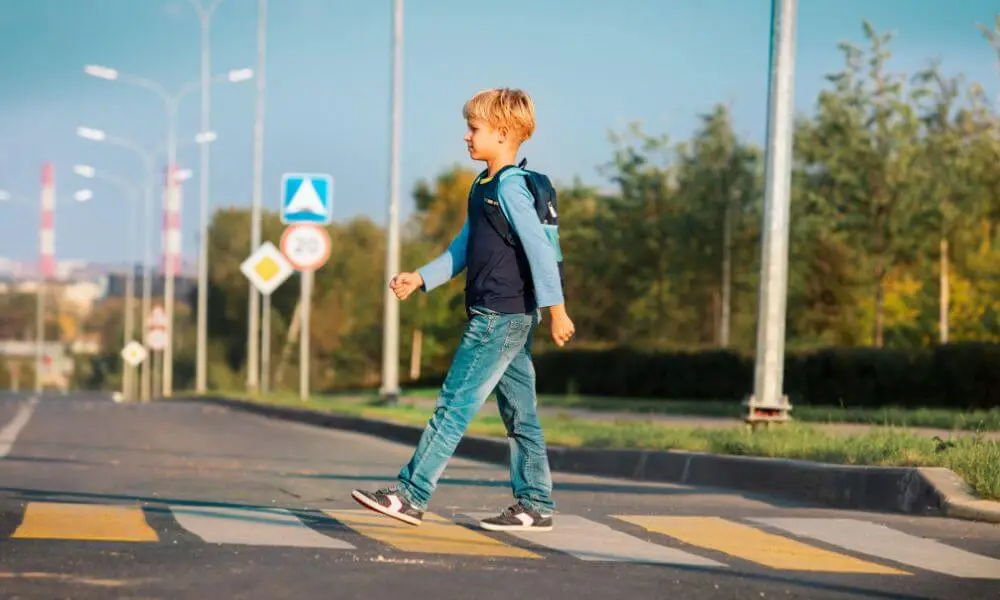As parents, the safety of our children is always a top priority. While they may have played safely within the familiar surroundings of our neighbourhood, it is essential to equip them with the knowledge and skills to navigate roads safely. “Road Safety for Kids” plays a vital role in their education, emphasizing obedience to traffic rules and fostering a habit of being cautious and aware. In this article, we will explore the importance of road safety for kids and discuss key traffic rules that every child should know.
Open discussions about road safety for kids and other safety points are invaluable. They help keep your children physically and mentally prepared for their journeys, fostering a sense of independence while ensuring they remain safe. Such conversations are more than just lessons; they are the building blocks of lifelong habits that will help your children navigate not just roads but many of life’s challenges.
Importance Of Road Safety For Kids
Ensuring the safety of our children is an ongoing responsibility, particularly when they venture out alone or with friends. While we strive to protect them at home and in school, we must also prepare them for the challenges of the road. Start teaching road safety when they are old enough to venture out independently. Engaging them through storytelling and role-playing can make the learning process more enjoyable and memorable. Tailor your lessons according to their age, gradually introducing more complex concepts as they grow older. Remember, teaching road safety is not just about rules but also about instilling cautious and confident behaviour in our children.
These numbers are a wake-up call. It’s crucial to start teaching your children about road safety as soon as they’re old enough to step outside independently. But how do you ensure they truly grasp these lessons? One effective method is through storytelling and role-playing. For instance, create a simple story about a child who safely crosses the street by following the rules, then act it out with your child. This makes the learning process engaging and helps them remember these vital rules.
Moreover, tailor your lessons to your child’s age. For younger children, focus on basic principles like ‘Stop, Look, and Listen,’ and as they grow older, introduce more complex concepts like understanding traffic signals and pedestrian rights.
Remember, teaching road safety is an ongoing conversation. It’s about more than just rules; it’s about instilling cautious but confident behaviour in your children, ensuring their safety wherever they go.
Traffic Rules To Ensure Road Safety For Kids
Understanding road safety is crucial for children, but it’s important to start with the basics to avoid overwhelming them. Here are some fundamental traffic rules that are perfect for beginners.
Understanding Traffic Lights
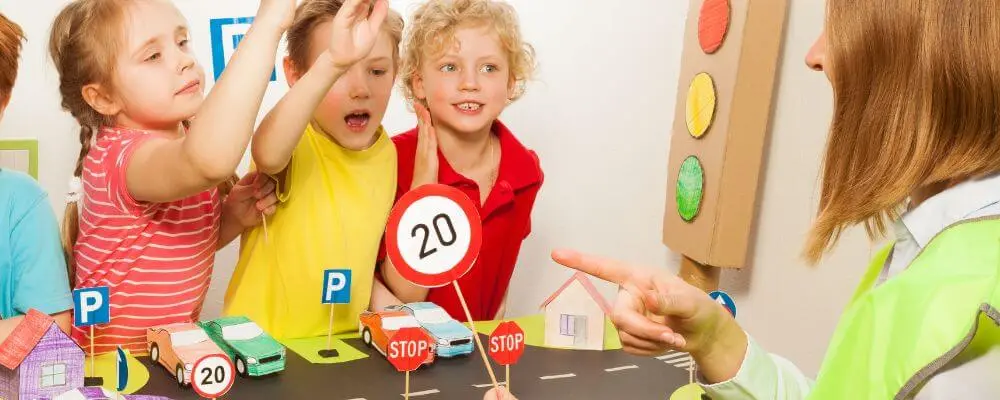
Teach your child about traffic lights and signs, and what each color means. You can make this more engaging by using flashcards or drawing the signals together.
- Green means ‘Go’: Explain that vehicles move only when the signal turns green. But remind them that even when the signal is green, they should still look both ways to ensure it’s safe before crossing.
- Red means ‘Stop’: Vehicles must stop at a red signal. Teach your child to never cross the road when the pedestrian signal is red.
- Yellow means ‘Slow Down’: A yellow signal means vehicles should slow down and prepare to stop. It’s a sign for pedestrians to be ready but wait.
- Pedestrian Signals: The ‘Walk’ sign or a walking man symbol means it’s safe to cross, but they should still be cautious and look left and right. Never cross on a ‘Don’t Walk’ signal or when the walking man symbol is red.
- Alternate Symbols: Sometimes, a hand symbol is used instead of the walking man or ‘Walk’ signals. Help your child recognize different pedestrian symbols.
When you’re out walking with your child, point out these signals and ask them to explain what each one means. This real-world practice reinforces their learning. Gradually, you can introduce them to more complex traffic signals and rules, building their knowledge and confidence in understanding road safety.
The Art of Safely Crossing Streets
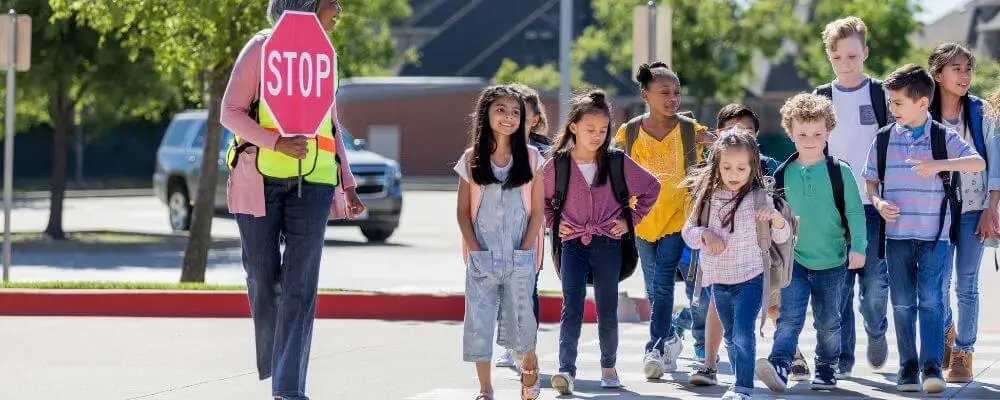
Whether your child is walking back from school, the bus stop, or just crossing the street to a friend’s house, it’s crucial they know how to do it safely. Here’s a fun and easy way to teach them:
First, create a memorable character, like a wise owl, to guide them through these steps. You can draw it together or find a picture.
- Always Look for Signals: Use pedestrian crossings whenever possible. The wise owl says, “Pedestrian crossings are our friends!”
- Look Both Ways: Look to your right and then to your left to check for any approaching vehicles. The wise owl reminds us, “Always use your eyes before your feet!”
- Wait for Vehicles to Pass: If there are coming cars, wait for them to pass before you cross. The owl advises, “Patience keeps us safe!”
- Never Cross at Bends: Bends are tricky because you can’t see cars coming. The owl says, “If you can’t see it, it can’t see you!”
- Avoid Crossing Between Stationary Vehicles: This can be dangerous as drivers may not see you. The wise owl warns, “Stay visible, stay safe!”
Remember, children under six should always have an adult accompanying them. Hold their hand just like the wise owl would with its little owlets!
By turning these rules into an interactive story with a character like the wise owl, you can make learning these safety rules both fun and memorable for your child.
Listen & Stay Safe
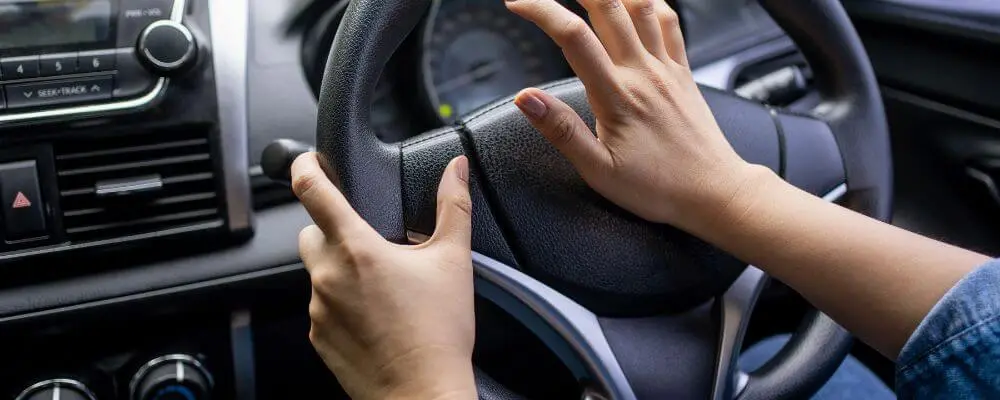
It’s important to teach your kids that sometimes, they won’t be able to see an oncoming vehicle, especially near tricky spots like bends. Here’s a fun and effective way to help them understand the importance of listening:
Create a game where you make different vehicle sounds together, explaining that sometimes they can’t rely on their eyes alone. Tell your children:
- Listen for Horns: If they hear a horn, imagine it as a ‘beep-beep’ alarm. This is the time to stop and look to the left and right to see if a vehicle is coming. The horn is like a talking car saying, “Watch out, I’m here!”
- Engine Sounds: Play a game of ‘Guess the Vehicle’ by listening. A loud noise can be a car saying, “I’m close by!” and a faint noise is like a distant “Hello!” from a far-away car. Teach them that loud sounds mean the vehicle is close, and faint sounds mean it’s further away.
Remind them to use their ‘superhero’ ears for listening, but also to keep their eyes open and be alert. This way, they’re using all their senses to stay safe.
By turning safety lessons into a game, children are more likely to remember and apply them in real-life situations. Always encourage them to be alert and attentive, making road crossing safer and more fun!
Road Safety: No Running

Teach your children the dangers of running across or along the road. Explain that when they run, it’s harder for drivers to see them, and they might not notice approaching cars. Turn it into a game where walking calmly is the winning move, and running is how you ‘lose’ the game.
Sidewalks: The Safe Path
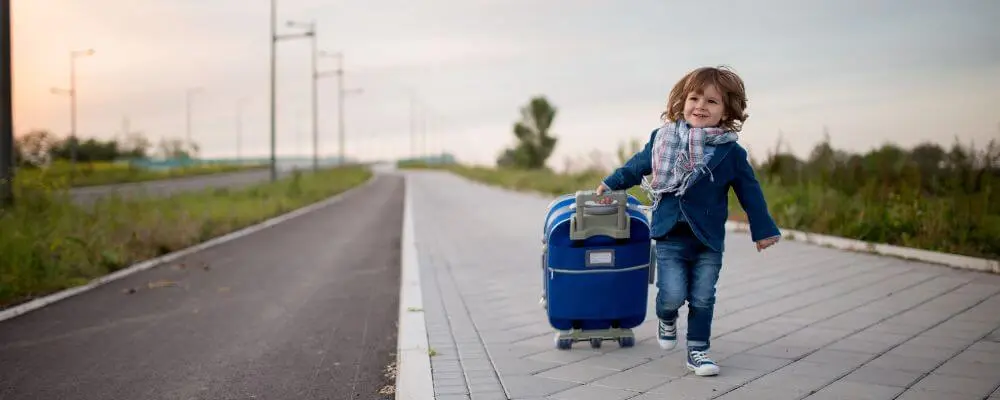
Children learn by example, so always use sidewalks when walking with them, and explain why they are safer. Create a simple rhyme or song about sidewalk safety that you can sing together during walks.
Crossroads And Pedestrian Crossing
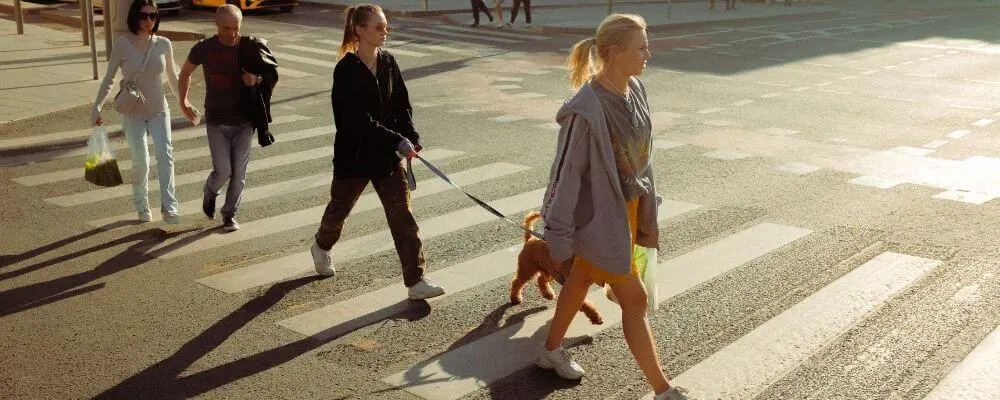
Explain to your kids the importance of crossing only at intersections and pedestrian crossings, where drivers are more likely to expect pedestrians. For areas without marked crossings, remind them of the ‘Stop, Look, and Listen’ game. Reinforce this message by practising it with them whenever you’re out.
Stay Inside: Vehicle Safety
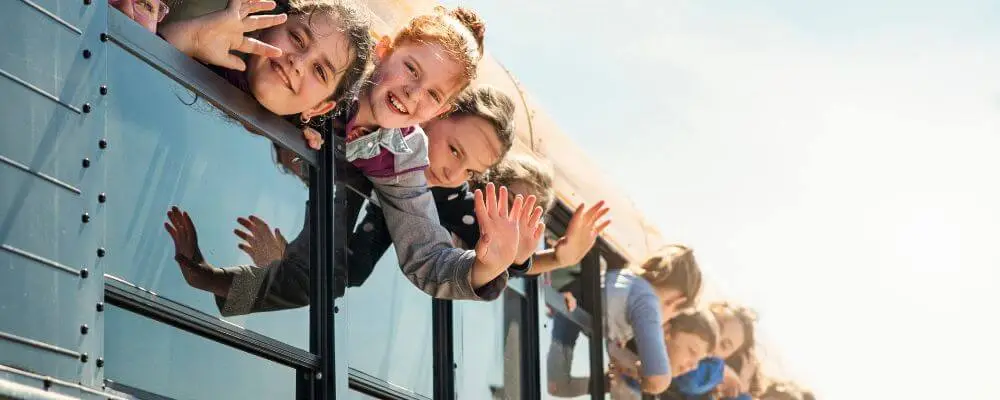
Explain to your kids that while it might seem fun to stick their hands or heads out of a school bus, it’s very dangerous. Use a simple analogy, like how we don’t touch hot things because they can burn us, to explain that sticking out limbs can lead to serious injuries, especially if there are vehicles close by.
Avoid Crossing at Bends
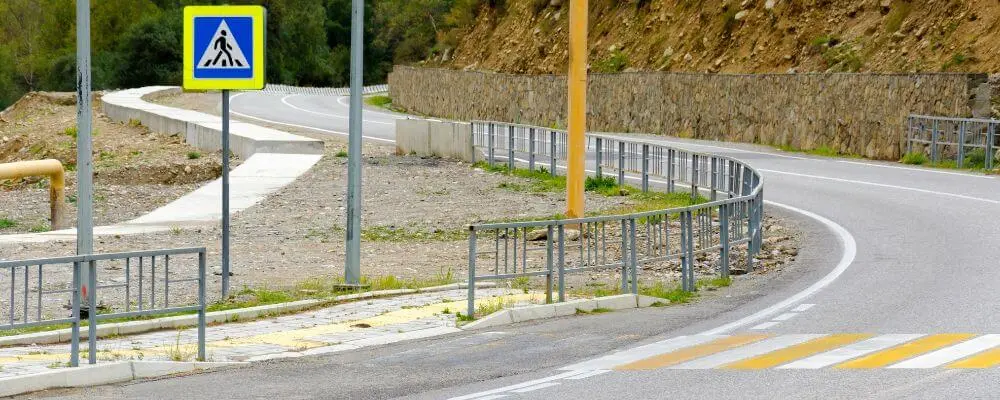
Teach your children that bends in the road are like hidden spots where drivers can’t see them well. Encourage them to find a straight part of the road to cross where they can see cars coming, and drivers can see them.
Bicycle Road Rules

For older kids who cycle, make safety fun and memorable:
- Helmet On: Turn wearing a helmet into a ‘superhero gear up’ routine.
- Bicycle Check: Create a simple ‘Bike Ready’ checklist, including brakes and lights.
- Right Riding: Practice with them where to ride on the road, emphasizing the importance of staying to the side and being aware of traffic, using a game-like approach.
- Visibility: Explain the importance of lights in dark or poor visibility areas using a ‘be seen, be safe’ slogan.
- Busy Streets Rule: Set a family rule: no riding on busy streets without a grown-up.
Safety Inside Moving Vehicles
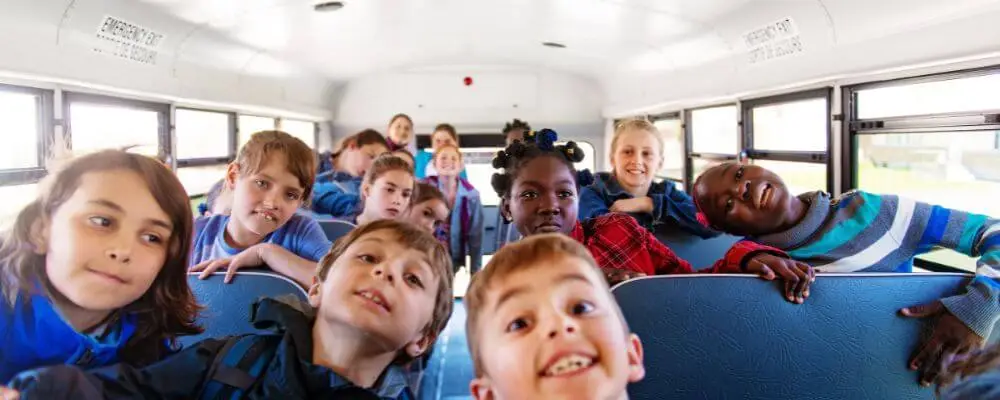
To ensure your child stays safe in a moving vehicle, like a car or school bus, teach them these simple rules:
- Stay Seated: Always sit down and never stand, especially in a moving bus or van. Explain that moving around can cause them to lose balance if the vehicle suddenly stops.
- Hold On: In a bus, hold on to the hard rail for support until the vehicle comes to a complete stop.
- Keep Inside: Remind them to keep all body parts inside the vehicle and not stick them out of the window.
Exit Safely: Use the Curbside
If your child uses a school bus, remember these tips:
- Be Early: Starting early can prevent the need to rush for the bus.
- Queue Up: Always stand in line when getting on or off the bus.
- Curbside Exit: Always get off the bus on the curbside to stay clear of traffic.
Be Visible, Stay Safe
Being visible to drivers is crucial, especially at night:
- Bright and Reflective: Wear light or reflective clothes at night and bright clothes during the day.
- Wave to Indicate: Teach them to wave their hand to show their presence to an oncoming vehicle.
Stay Calm, Don’t Rush
Teaching kids not to rush is important for their safety:
- Calm Entry and Exit: Explain the importance of getting in and out of vehicles calmly to avoid accidents.
- No Sudden Moves: Teach them not to make unexpected moves that could surprise you or drivers.
- Stay Calm on the Streets: Encourage calm behaviour on the streets and avoid playing in unsafe areas like bus bays or roads.
- Car Door Safety: Instruct them to wait for your signal before opening car doors.
Conclusion
Instilling road safety awareness in our children is essential for their well-being and future. By teaching them traffic rules and developing good habits, we empower them to navigate roads responsibly and confidently. The journey to road safety doesn’t end with these lessons; it requires continuous updates and revisits as children grow. Let us demonstrate responsible driving, attentive pedestrian behaviour, and considerate road usage, for by leading by example, we create a safer community for everyone. Together, we can positively impact road safety, ensuring that our children are equipped for the challenges of the real world.
Please Like Our Facebook Page | Home
